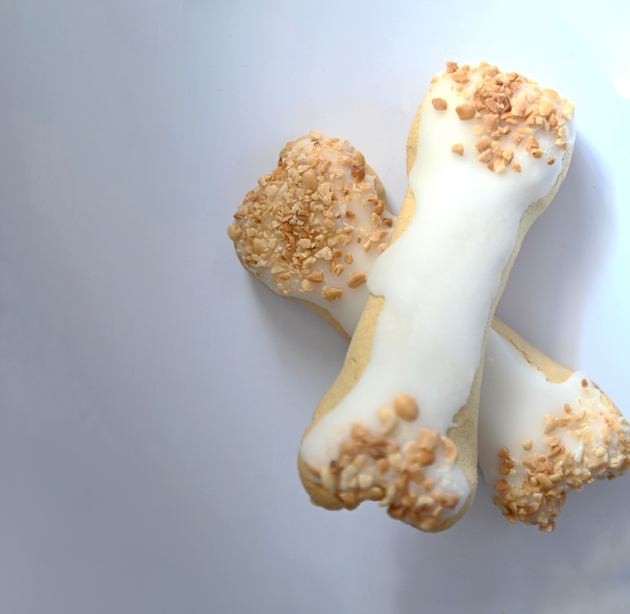These sweet almond biscuits are the OG Halloween treat on the Maltese Islands, where culinary traditions are often dictated by religious feasts.
Words by Adriana Bishop
First things first: we’re talking about biscuits. Just in case you may be wondering if you’ve stumbled across a ghoulish article about anatomy or some unsavoury Maltese fetish for human bones, rest assured, Dead Men’s Bones are just sweet treats. Albeit in the shape of bones. And they do represent dead people. But the morbid references end there.
Malta has a long-standing tradition linking religion and food. The religious calendar, reflecting seasonal produce, would dictate the type of food that could be eaten on certain days, especially the days of fasting in the lead up to an important feast such as Easter, followed by gluttonous celebrations, with dining tables groaning under the weight of delicious abundance. For example, dinner on Wednesdays, Fridays, Saturdays and the eve of feasts would always consist of fish.
Long before the Americanised version of Halloween swept over the Maltese shores, sparking a colourful festival of friendly ghosts and tacky trinkets, the last day of October was just another day in the calendar, while the first and second days of November were, and are still, commemorated as the feasts of All Saints and All Souls. Or, if you are of school age, mid-term holidays.
In fact, the whole month of November is dedicated to the memory of our dead loved ones, when we make it a point to visit the cemetery to clean their tombs. There was a time when priests would display empty coffins outside the churches to remind their parishioners of the afterlife. Perhaps in a fitting lead up to the jollity of Christmas a month away, November is a sombre time of reflection on life and death.
The month of the dead has its own culinary traditions, mostly related to sharing food with your less fortunate neighbours. Dead Men’s Bones (in Maltese, Għadam tal-Mejtin) are the sweetest of such a tradition, in all senses, and are still as popular today as ever. On November 2, the feast of All Souls, Mass would be celebrated in remembrance of the departed who have not yet reached paradise and are still in purgatory. Children would give up sweets on that day and leave a piece of cloth under their pillow when they go to sleep. In the morning, they would find some sweets wrapped in that cloth napkin in another tradition known as is-Sarvetta ta’ l-Erwieħ (the napkin of All Souls).

Villagers or a religious community would get together to prepare a large pot of “All Souls Soup” full of cheap but nutritious vegetables and pasta to be distributed among the village poor. Up till the brink of World War II, some villages would prepare the ħanżira ta’ l-erwieħ, when a pig, often donated by a generous family, would be allowed to roam freely through the streets, fed with scraps until fattened enough to be slaughtered and cooked for an All Souls roast pork feast for the poor.
Food writer Matty Cremona recounts how in the years before World War II, there used to be a procession on All Saints' Day, when beggars and other hungry people would knock on doors calling for karità (charity) while holding out bowls for bread or flour. “This may have its roots in the old practice of vowing to give some wheat to the poor in honour of the dead or in thanksgiving for a prayer answered,” writes Cremona in her book The Way We Ate - Memories of Maltese Meals.
While there is no clear historical reference to the origins of Dead Men’s Bones biscuits, their similarity to the more cheerful Easter figolli, with their sweet pastry encasing an almond filling, hints at the possibility that they might date back to the 17th century, with the first mention of figolli registered in 1660.
At an average of 14cm in length, the biscuits are roughly half the size of an adult humerus bone (that’s your upper arm) and are not only shaped like bones but are also covered in white icing to complete the anatomical picture. The thick sweet pastry wraps around an inner marrow of ground almonds, a staple of Maltese celebratory desserts, mixed with a generous amount of sugar, egg whites and grated lemon rind.
The bone shape is intentional as it is meant to serve as a memento mori, a reminder of people’s “devotion towards the dead”, and sometimes, the bakers went as far as creating biscuits in the shape of skulls and crossbones.
Today, Dead Men’s Bones can be easily found in all bakeries and supermarkets, and some producers are even experimenting with pistachio filling as an alternative to the traditional almonds, although I’m not sure what the dead would make of this unorthodox novelty.
How to make Għadam tal-Mejtin
Recipe adapted from The Way We Ate – Memories of Maltese Meals by Matty Cremona
INGREDIENTS
SERVES 10 – 12
For the pastry
- 400g flour
- 100g caster sugar
- 200g butter
- 2 egg yolks
For the filling
- 300g finely ground almonds
- 300g caster sugar
- Grated rind of a large lemon
- 2 egg whites
METHOD
Rub the butter into the flour and sugar. Add the yolks. Stir to form a dough. If the mixture is too dry add a drop of water. Set aside.
Stir together the dry ingredients for the filling. Add the egg whites. Stir to make a fairly dry paste. Break off pieces and mould into classic bone shapes. Roll out the pastry and cut it into square pieces large enough to roll around the bone-shaped bits of almond filling. Wrap the filling up in the pastry, tucking it around to make a neat bone shape.
Bake at gas mark 5/190°C for about 30 minutes or until they are golden brown. Cool the biscuits on a rack before coating them with thick white glacé icing or royal icing.
